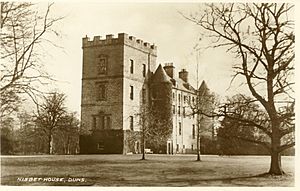Nisbet House facts for kids
Nisbet House is a large, old house built in the 1600s in the Scottish Borders. It sits near the Blackadder Water river, about 2.5 kilometers south of Duns. This area is known as the Merse, a flat part of the old county of Berwickshire.
Sir Alexander Nisbet built the house around 1630. He was an ancestor of Alexander Nisbet, who was famous for studying family crests and symbols. Parts of the house, especially the eastern side, seem to have been built around an even older, square tower. Nisbet House is considered a very important historical building in Scotland.
A Look at Its Past
The Nisbet family built two strong, fortified houses called pele towers in the 1100s. These were East Nisbet and West Nisbet. East Nisbet is now called Allanbank, and its original tower is gone. West Nisbet is the house we see today. It was made much bigger in the 1630s.
Sir Alexander Nisbet, who owned the house at that time, spent too much money helping King Charles I during the English Civil War. Because of this, he had to sell Nisbet House in 1652 to John Ker. John Ker's son, George Carre, Lord Nisbet, was born here around 1700.
In 1774, another square tower was added to the west side of the house. This new part had beautiful plasterwork inside. The house stayed with the Ker family and their relatives until the 1950s. Then, it was sold to Lord Brocket. After some updates, it was sold again in the mid-1960s to a local farmer. The house was empty for a while until it was fully fixed up and became a private home again.
The Estate Around the House
The land that used to belong to Nisbet House has a few interesting features. There's a very small old mill and a stable building from the 1700s. This stable used to be shaped like a "U" and has now been turned into homes. You can also find a few cottages and farmhouses scattered around.
Just north of the Nisbet estate is Dunse Spa. In the 1700s, this was a place where people would go for its special mineral water. The building for the spa is still there today.
Gallery
Photographs of Nisbet House taken by Robert Chancellor Nesbit in the 1930s.






